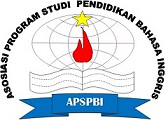TEACHING MULTIMODAL LITERACY THROUGH INTEGRATED LEARNING OF ADVERTISEMENT TEXTS
Abstract
Keywords
Full Text:
PDFReferences
Afandi, M., Chamalah, E., Wardani, O. P., & Gunarto, H. (2013). Model dan metode pembelajaran. Semarang: Unissula. https://www.academia.edu/download/55856965/9230susun_ISI_DAN_DAFTAR_PUSTAKA_BUKU_MODEL_edit_.pdf
Arikunto, S. (2006). Metode penelitian kualitatif. Jakarta: Bumi Aksara.
Bao, X. (2017). Application of multimodality to teaching reading. English Language and Literature Studies, 7(3), (pp. 78-84). DOI:10.5539/ells.v7n3p78
Bezemer, J., & Kress, G. (2008). Writing in multimodal texts: A social semiotic account of designs for learning. Written communication, 25(2), (pp. 166-195). https://doi.org/10.1177/0741088307313177
Block, J. H. (1971). Criterion-referenced measurements: Potential. The School Review, 79(2), (pp. 289-298). https://doi.org/10.1086/442975
Carnevale, A. P., Jayasundera, T., & Repnikov, D. (2014). Understanding online job ads data. Georgetown University, Center on Education and the Workforce, Technical Report (April).
Coccetta, F. (2018). Developing university students’ multimodal communicative competence: Field research into multimodal text studies in English. System, 77, (pp. 19-27). https://doi.org/10.1016/j.system.2018.01.004
Cooper, P., & Stewart, L. (1982). Language Skills in the Classroom. What Research Says to the Teacher. National Education Association, Order Department, The Academic Building, Saw Mill Rd., West Haven, CT 06516. https://eric.ed.gov/?id=ED222912
Djamarah, S. B., & Zain, A. (2010). Strategi Belajar Mengajar. Kemampuan Spasial. Jakarta: Rineka Cipta.
Eriyanto. (2001). Analisis wacana: pengantar analisis teks media. LKiS Yogyakarta.
Fahyuni; Nurdiansyah. (2016). Inovasi Model Pembelajaran.
Fajriah, Y. N., Hamied, F. A., & Gunawan, W. (2021). Image-text relation interpretation: teachers’visual-verbal competence in teaching texts. Jurnal Cakrawala Pendidikan, (pp. 208-217). DOI:10.21831/cp.v40i1.33755
Firmansyah, M. B. (2018). MULTIMODAL CONCEPTION IN LEARNING. ISLLAC: Journal of Intensive Studies on Language, Literature, Art, and Culture, 2(1), (pp. 40- 44).
Freyn, A. L. (2017). Effects of a Multimodal Approach on ESL/EFL University Students' Attitudes towards Poetry. Journal of Education and Practice, 8(8), (pp. 80-83). https://eric.ed.gov/?id=EJ1139053
Halliday, M. A. K. (1978). Language as social semiotic: The social interpretation of language and meaning. Hodder Education.
Halliday, M. A. K., & Hasan, R. (1992). Bahasa, konteks, dan teks. Yogyakarta: Gadjah Mada University Press.
Hite, R. E., & Bellizzi, J. A. (1986). Consumers Attitudes Toward Accountants, Lawyers, and Physicians with Respect to Advertising Professional Services. Journal of Advertising Research, 26(3), (pp. 45-54).
Kennedy, V. (2014). Critical, cultural and multimodal approaches to using song as literature in language learning. Libri et liberi: časopis za istraživanje dječje književnosti i kulture, 3(2), (pp. 295-310). https://hrcak.srce.hr/132483
Kress, G., & Van Leeuwen, T. (1996). The grammar of visual design. London and New York: Routledge.
Kress, G., & Van Leeuwen, T. (2020). Reading images: The grammar of visual design. Routledge. https://doi.org/10.4324/9781003099857
Kusuma, A. H. P., Sudirman, A., & Purnomo, A. (2020). Brand Management: Esensi, Posisi dan Strategi. Yayasan Kita Menulis.
Mudra, H. (2020). Digital literacy among young learners: How do EFL teachers and learners view its benefits and barriers?. Teaching English with Technology, 20(3), (pp. 3-24).
Nasir, M. (2018). Pendidikan Tinggi Berkualitas: “Mendorong Kemajuan IPTEK, Inovasi, dan Daya Saing Bangsa di Era Revolusi Industri 4.0”.
Nelson, P. (1974). Advertising as information. Journal of political economy, 82(4), (pp. 729-754). https://doi.org/10.1086/260231
Nuryadi, A., Faisal, I., & Budiman, A. (2018). ANALISIS PENGARUH PERIPHERAL COMMUNICATION PROCESSING DENGAN PENGGUNAAN AGNEZ MO SEBAGAI CELEBRITY ENDORSER PADA IKLAN FRESHCARE TERHADAP MINAT BELI (Studi Pada Konsumen FreshCare Di Kota Banjarmasin). JURNAL SAINS MANAJEMEN DAN KEWIRAUSAHAAN, 3(2), (pp. 57-69). http://ppjp.ulm.ac.id/journal/index.php/jsmk
Piliang, Y. A. (2004). Iklan, Informasi, atau Simulasi?: Konteks Sosial dan Kultural Iklan. Mediator: Jurnal Komunikasi, 5(1), 63-73. https://doi.org/10.29313/mediator.v5i1.1034
Rossiter, J. R., & Percy, L. (1987). Advertising and promotion management. McGraw-Hill Book Company. https://psycnet.apa.org/record/1987-97569-000
Syaodih, E. (2007). ENGEMBANGAN MODEL PEMBELAJARAN KOOPERATIF UNTUK MENINGKATKAN KETERAMPILAN SOSIAL. Educare. http://jurnal.fkip.unla.ac.id/index.php/educare/article/view/51
Tampubolon, D. P. (1987). Kemampuan Membaca Teknik Membaca Efektif Efisien. Bandung: Percetakan Angkasa.
Widyastuti, Putri Anggraeni. (2021). "Perubahan Analisis Sosial Dan Semiotika Desain Iklan Acara Cosplay Di Jakarta Pada Majalah Animonster Periode Tahun 2004-2014." In Prosiding Seminar Nasional Desain Sosial (SNDS), vol. 1, no. 1, (pp. 145-153). https://ojs.uph.edu/index.php/SNDS/article/view/3228/0
Yi, Y., Shin, D. S., & Cimasko, T. (2019). Multimodal literacies in teaching and learning English in and outside of school. The Handbook of TESOL in K‐12, (pp. 163-177).
https://doi.org/10.1002/9781119421702.ch11
Yuen, C. Y. (2004). The construal of ideational meaning in print advertisements. Multimodal discourse analysis: Systemic functional perspectives, 2(1), (pp. 163-252). https://www.academia.edu/download/34184705/multimodal_DA.pdf#page=172
Yulitasari, Y. (2019). Multimodal literasi: media piktogram dalam keterampilan membaca pemahaman bahasa asing tingkat A1. In Prosiding Seminar Nasional Linguistik dan Sastra (SEMANTIKS) (Vol. 1, pp. 561-564). https://jurnal.uns.ac.id/prosidingsemantiks
DOI: http://dx.doi.org/10.20527/jetall.v6i1.15340
Article Metrics
Abstract view : 536 timesPDF - 443 times
Refbacks
- There are currently no refbacks.
This journal is indexed in:


This Journal is listed in:
 Journal of English Teaching, Applied Linguistics and Literatures (JETALL)
Journal of English Teaching, Applied Linguistics and Literatures (JETALL)









.png)



1.png)
